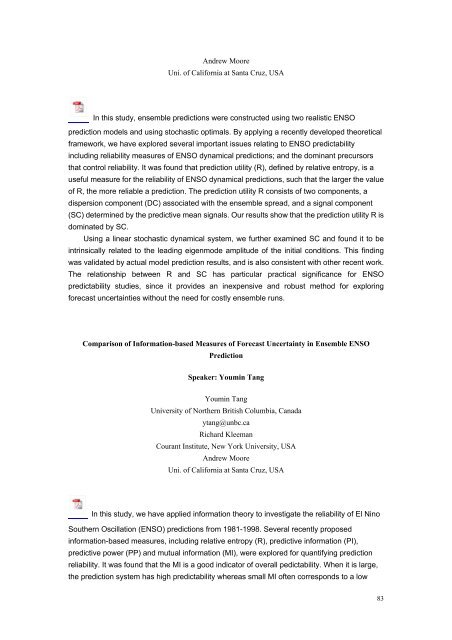The tenth IMSC, Beijing, China, 2007 - International Meetings on ...
The tenth IMSC, Beijing, China, 2007 - International Meetings on ...
The tenth IMSC, Beijing, China, 2007 - International Meetings on ...
Create successful ePaper yourself
Turn your PDF publications into a flip-book with our unique Google optimized e-Paper software.
Andrew Moore<br />
Uni. of California at Santa Cruz, USA<br />
In this study, ensemble predicti<strong>on</strong>s were c<strong>on</strong>structed using two realistic ENSO<br />
predicti<strong>on</strong> models and using stochastic optimals. By applying a recently developed theoretical<br />
framework, we have explored several important issues relating to ENSO predictability<br />
including reliability measures of ENSO dynamical predicti<strong>on</strong>s; and the dominant precursors<br />
that c<strong>on</strong>trol reliability. It was found that predicti<strong>on</strong> utility (R), defined by relative entropy, is a<br />
useful measure for the reliability of ENSO dynamical predicti<strong>on</strong>s, such that the larger the value<br />
of R, the more reliable a predicti<strong>on</strong>. <str<strong>on</strong>g>The</str<strong>on</strong>g> predicti<strong>on</strong> utility R c<strong>on</strong>sists of two comp<strong>on</strong>ents, a<br />
dispersi<strong>on</strong> comp<strong>on</strong>ent (DC) associated with the ensemble spread, and a signal comp<strong>on</strong>ent<br />
(SC) determined by the predictive mean signals. Our results show that the predicti<strong>on</strong> utility R is<br />
dominated by SC.<br />
Using a linear stochastic dynamical system, we further examined SC and found it to be<br />
intrinsically related to the leading eigenmode amplitude of the initial c<strong>on</strong>diti<strong>on</strong>s. This finding<br />
was validated by actual model predicti<strong>on</strong> results, and is also c<strong>on</strong>sistent with other recent work.<br />
<str<strong>on</strong>g>The</str<strong>on</strong>g> relati<strong>on</strong>ship between R and SC has particular practical significance for ENSO<br />
predictability studies, since it provides an inexpensive and robust method for exploring<br />
forecast uncertainties without the need for costly ensemble runs.<br />
Comparis<strong>on</strong> of Informati<strong>on</strong>-based Measures of Forecast Uncertainty in Ensemble ENSO<br />
Predicti<strong>on</strong><br />
Speaker: Youmin Tang<br />
Youmin Tang<br />
University of Northern British Columbia, Canada<br />
ytang@unbc.ca<br />
Richard Kleeman<br />
Courant Institute, New York University, USA<br />
Andrew Moore<br />
Uni. of California at Santa Cruz, USA<br />
In this study, we have applied informati<strong>on</strong> theory to investigate the reliability of El Nino<br />
Southern Oscillati<strong>on</strong> (ENSO) predicti<strong>on</strong>s from 1981-1998. Several recently proposed<br />
informati<strong>on</strong>-based measures, including relative entropy (R), predictive informati<strong>on</strong> (PI),<br />
predictive power (PP) and mutual informati<strong>on</strong> (MI), were explored for quantifying predicti<strong>on</strong><br />
reliability. It was found that the MI is a good indicator of overall pedictability. When it is large,<br />
the predicti<strong>on</strong> system has high predictability whereas small MI often corresp<strong>on</strong>ds to a low<br />
83






![final_program_abstracts[1]](https://img.yumpu.com/19102520/1/174x260/final-program-abstracts1.jpg?quality=85)









